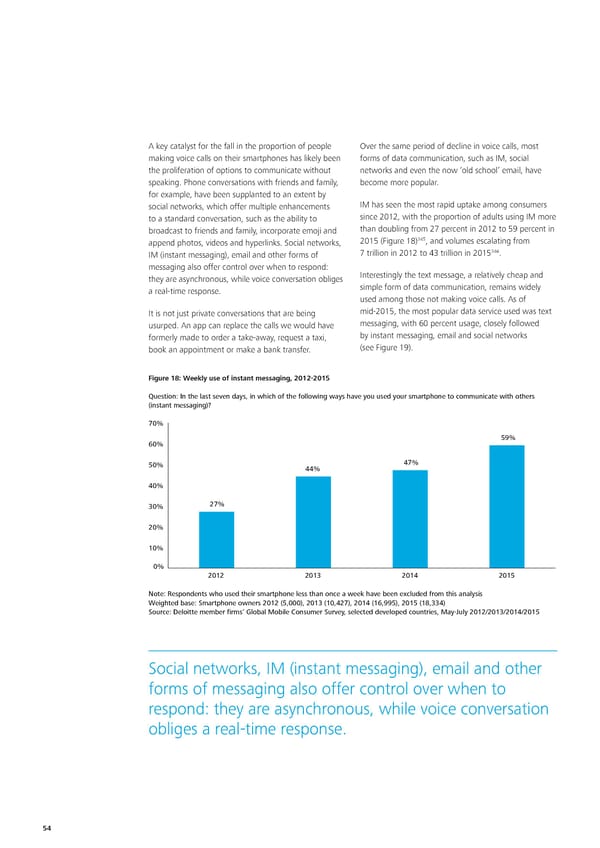A key catalyst for the fall in the proportion of people Over the same period of decline in voice calls, most making voice calls on their smartphones has likely been forms of data communication, such as IM, social the proliferation of options to communicate without networks and even the now ‘old school’ email, have speaking. Phone conversations with friends and family, become more popular. for example, have been supplanted to an extent by social networks, which offer multiple enhancements IM has seen the most rapid uptake among consumers to a standard conversation, such as the ability to since 2012, with the proportion of adults using IM more broadcast to friends and family, incorporate emoji and than doubling from 27 percent in 2012 to 59 percent in 345 append photos, videos and hyperlinks. Social networks, 2015 (Figure 18) , and volumes escalating from 346 IM (instant messaging), email and other forms of 7 trillion in 2012 to 43 trillion in 2015 . messaging also offer control over when to respond: they are asynchronous, while voice conversation obliges Interestingly the text message, a relatively cheap and a real-time response. simple form of data communication, remains widely used among those not making voice calls. As of It is not just private conversations that are being mid-2015, the most popular data service used was text usurped. An app can replace the calls we would have messaging, with 60 percent usage, closely followed formerly made to order a take-away, request a taxi, by instant messaging, email and social networks book an appointment or make a bank transfer. (see Figure 19). Figure 18: Weekly use of instant messaging, 2012‑2015 Question: In the last seven days, in which of the following ways have you used your smartphone to communicate with others (instant messaging)? 70% 59% 60% 50% 47% 44% 40% 30% 27% 20% 10% 0% 2012 2013 2014 2015 Note: Respondents who used their smartphone less than once a week have been excluded from this analysis Weighted base: Smartphone owners 2012 (5,000), 2013 (10,427), 2014 (16,995), 2015 (18,334) Source: Deloitte member firms’ Global Mobile Consumer Survey, selected developed countries, May-July 2012/2013/2014/2015 Social networks, IM (instant messaging), email and other forms of messaging also offer control over when to respond: they are asynchronous, while voice conversation obliges a real-time response. 54
 Technology, Media & Telecommunications Predictions Page 62 Page 64
Technology, Media & Telecommunications Predictions Page 62 Page 64